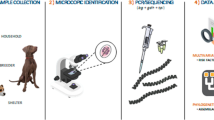Abstract
In the genus Giardia (G.) intestinalis is the only species found in humans as well as in other mammals, including domestic and farm animals. Molecular characterisation of strains isolated from different hosts revealed the existence of sevenmajor genotypic assemblages. Assemblage A and B isolates have been recovered from a broad range of hosts, including humans, livestock, cats, dogs, beavers and guinea pigs. Infection and subsequent cyst shedding contaminates the environment for all mammals, including humans. In this preliminary investigation we studied the prevalence of Giardia infection in kennel dogs from Hungary by microscopic examinations and using a G. intestinalis Agspecific coproantigen test. In order to investigate the genotypes of Giardia, a nested PCR specific for Giardia 18S-rDNA was introduced. All sequenced samples displayed the sequences described for Assemblage D and C dog-specific G. intestinalis strains. These results indicate, however, that dog giardiosis is highly prevalent in the studied geographical areas, but it doesn’t present severe zoonotic potential. In the course of the study, the higher sensitivity of the coproantigen test compared to microscopy, and the significant decline in the infection rate with the increasing age of the dogs sampled was clearly pointed.
Similar content being viewed by others
References
Adam RD (2001). Biology of Giardia lamblia. Clin Microbiol Rev 14:447–475.
Berrilli F, Di Cave D, De Liberato C, Franco A, Scaramozzino P, Orecchia P (2004). Genotype characterisation of Giardia duodenalis isolates from domestic and farm animals by SSU-rRNA gene sequencing. Vet Parasitol 122:193–199.
Boreham PFL, Upcroft JA, Upcroft P (1990). Changing approaches to the study of Giardia epidemiology: 1681–2000. Int J Parasitol 20:479–487.
Bryan RT, Pinner RW, Berkelman (1994). Emerging infections in the United States. Am N Y Acad Sci 740:346–361.
Fraser D (1994). Epidemiology of Giardia lamblia and Cryptosporidium infections in childhood. Isr J Med Sci 30:356–361.
Gardner TB, Hill DR (2001). Treatment of Gardiasis. Clin Microbiol Reviews 14:114–128.
Hanson KL, Cartwright CP (2001). Use of an enzyme immunoassay does not eliminate the need to analyze multimultiple stool specimens for sensitive detection of Giardia lamblia. J Clin Microbiol 39:474–477.
Hart CA, Trees AJ, Duerden BI (1997). Zoonoses. J Med Microbiol 46:4–33.
Heyworth MF (1992). Immunology of Giardia and Cryptosporidium infections. J Infect Dis 166:465–472.
Heyworth MF (1996). Giardia infections. In: Paradise LJ, Bendinelli M, Friedman H (eds) Enteric Infections and Immunity. Plenum Press, New York, pp. 227–238.
Hopkins RM,Meloni BP, Groth DM, Wetherall JD, Reynoldson JA, Thompson RC (1997). Ribosomal RNA sequencing reveals differences between the genotypes of Giardia isolates recovered from humans and dogs living in the same locality. J Parasitol 83(1):44–51.
Hunter PR, Thompson RC, (2005) The zoonotic transmission of Giardia and Cryptosporidium. Int J Parasitol, 11–12: 1181–1190.
Isaac-Renton JL (1993). Giardiasis: Epidemiology and diagnosis. Semin Gastrointest Dis 4:206–213.
KramerMH, Herwaldt BL, Craun GF, Calderon RL, Juranek DD (1996). Surveillance for water-borne-disease outbreaks – United States, 1993–1994. CDC Surveillance Summaries, April 12, 1996. Morb Mortal Wkly Rep 45:1–30.
Macpherson CNL, Gottstein B, Geerts S (2000). Parasitic foodborne and water-borne zoonoses. Rev Sci Tech 19:240–258.
Majewska AC (1994). Successful experimental infections of a human volunteer and Mongolian gerbils with Giardia of animal origin. Trans R Soc Trop Med Hyg 88:360–362.
Marshall MM, Naumovitz D, Ortega Y, Sterling CR (1997). Water-borne protozoan pathogens. Clin Microbiol Rev 10:67–85.
McGlade TR, Robertson ID, Elliot AD, Thompson RCA (2003). High prevalence of Giardia detected in cats by PCR. Vet Parasitol 110:197–205.
Meloni BP, Lymbery AJ, Thompson RCA (1995). Genetic characterization of isolates of Giardia duodenalis by enzyme electrophoresis: implications for reproductive biology, population structure, taxonomy and epidemiology. J Parasitol 81:368–383.
Monis PT, Mayrhofer G, Andrews RH, Homan WL, Limper L, Ey PL (1996).Molecular genetic analysis of Giardia intestinalis isolates at the glutamate dehydrogenase locus. Parasitology 112:1–12.
Robertson LJ, Hermansen L, Gjerde BK, Strand E, Alvsvag JO, Langeland N (2006). Application of genotyping during an extensive outbreak of water-borne Giardiasis in Bergen, Norway, during autumn and winter 2004. Appl Environ Microbiol 72:2212–2217.
Santin M, Trout JM, Vecino JA, Dubey JP, Fayer R (2006). Cryptosporidium, Giardia and Enterocytozoon bieneusi in cats from Bogota (Colombia) and genotyping of isolates. Vet Parasitol 141:334–339.
Szénási Z (2004). Giardiosis 2. Az orvosi és az állatorvosi vonatkozások kapcsolódása. [Giardiosis 2 – Linking medical and veterinary aspects] – in Hungarian, Állatorv Prax (Vet Prax) 1:30–34.
Szénási Z, Krisztalovics K, Kádár M (2004). The Giardiasis. Epinfo – in Hungarian 31:379–383.
Szénási Z, Kucsera I, Horváth KN,Márton P, Orosz E, Danka J, Menyhárt K, Szeidemann Z (2005). Giardiosis 3. Egy zoonotikus protozoon, a Giardia duadenalis, emberi és állati elöfordulási gyakorisága és molekuláris biológiai karakterizálása. [Giardiosis 3. Themolecular biological characterization and the prevalence of the zoonotic protozoon, Giardia duodenalis in humans and animals] – in Hungarian, Állatorv Prax (Vet Prax) 2:18–21.
Thompson RC, Reynoldson JA, Mendis AHW (1993). Giardia and Giardiasis. Adv Parasitol 32:72–160.
Thompson RC, Hopkins RM, Homan WL (2000). Nomenclature and genetic groupings of Giardia infecting mammals. Parasitol Today 16:210–213.
Traub RJ, Monis PT, Robertson I, Irwin P, Mencke N, Thompson RC (2004). Epidemiological and molecular evidence supports the zoonotic transmission of Giardia among humans and dogs living in the same community. Parasitology 128:253–262.
Trout JM, Santin M, Fayer R (2006). Giardia and Cryptosporidium species and genotypes in coyotes (Canis latrans). J Zoo Wildl Med 37:141–4.
Várkonyi Á (1999). Giardiasis a gastroenterologus szemszögéböl. (Giardiasis from the aspect of gastroenterologists). – in Hungarian with English summary, Infektol Klin Mikrobiol 6:79–82.
Várnai F (ed) (1973). Trópusi betegségek (Tropical Diseases). Medicina Könyvkiadó, Budapest. – inHungarian, pp. 190–192.
Author information
Authors and Affiliations
Corresponding author
Rights and permissions
About this article
Cite this article
Szénási, Z., Marton, S., Kucsera, I. et al. Preliminary Investigation of the Prevalence and Genotype Distribution of Giardia intestinalis in Dogs in Hungary. Parasitol Res 101 (Suppl 1), 145–152 (2007). https://doi.org/10.1007/s00436-007-0622-8
Published:
Issue Date:
DOI: https://doi.org/10.1007/s00436-007-0622-8



